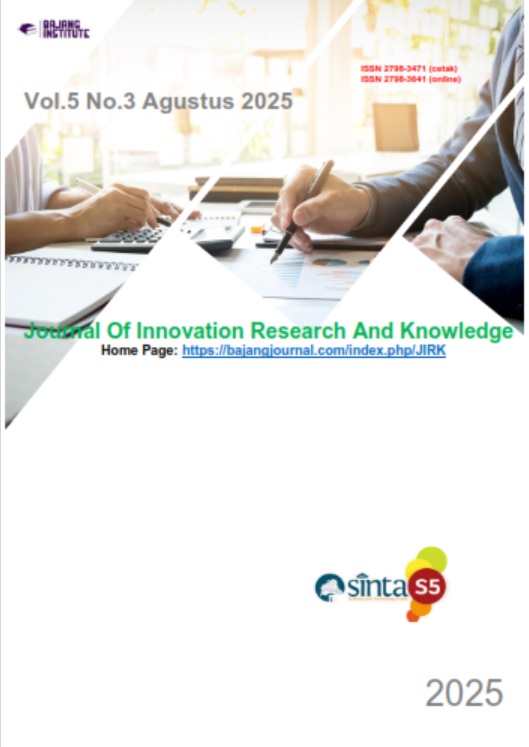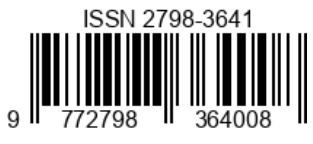EFEK MEANINGFUL LEARNING TERHADAP KEMAMPUAN BERPIKIR KRITIS MATEMATIKA SISWA SEKOLAH DASAR: PERAN MODEL PEMBELAJARAN NUMBER HEADS TOGETHER BERBANTUAN GEOBOARDS
Keywords:
Meaningful Learning, Number Heads Together, Geoboards, Mathematical Critical ThinkingAbstract
One of the 21st century skills is the ability to think critically. Critical thinking skills are essential for learning mathematics in elementary school. The purpose of this study is to determine the effect of meningful learning in the learning of Number Heads Together (NHT) assisted by geoboard media on the mathematical critical thinking ability of elementary school students. This study applies a quantitative research method with a One-Group Pretest-Posttest design. This design involved a sati experimental group, where there was no control group. There is a pretest before treatment and a posttest after treatment, so that the researcher can see the effect of treatment more accurately because it allows for a comparison of conditions before and after treatment. The geoboard-assisted NHT learning applied in this study is effective in improving the critical thinking skills of students in elementary schools. This increase is statistically proven through the non-parametric Wilcoxon Signed Ranks Test which is appropriate to be used when the data is not normally distributed, namely the value of Z = -2.889 with a significance level of 0.004 which is < 0.005 which shows a difference between conventional learning carried out by teachers and learning using the NHT model assisted by geoboards. The implementation of NHT assisted by geoboards encourages active discussion, conceptual understanding, and thorough student engagement, so it is highly recommended for mathematics learning in elementary schools in building students' critical thinking skills
References
Aditya, B. R., Jannah, F., & Nurhas, I. (2022). Problem-based numbered head together learning approach for a successful teaching strategy. JINoP (Jurnal Inovasi Pembelajaran), 8(1), 84–94. https://doi.org/10.22219/jinop.v8i1.20861
Al Kibtiyah, M., & Khairil, I. (2022). The Effect of Numbered Heads Together (NHT) Cooperative Learning Model Assisted by Audio Visual Media on Learning Outcomes of Elementary School Students. Jurnal Paedagogy.
Alfayez, M. Q. E., Aladwan, S. Q. A., & Shaheen, H. R. A. (2022). The Effect of a Training Program Based on Mathematical Problem-Solving Strategies on Critical Thinking Among Seventh-Grade Students. Frontiers in Education, 7(April), 1–9. https://doi.org/10.3389/feduc.2022.870524
Ausubel. (1968). Educational Psychology: A Cognitive View. Holt, Rinehart & Winston.
Badri, S. (2012). Metode Statistika Untuk Penelitian Kuantitatif. Ombak (Anggota IKAPI).
Gillies. (2016). Cooperative learning: Review of research and practice. Australian Journal of Teacher Education, 3(41).
Gurmu, F., Tuge, C., & Hunde, A. B. (2024). Effects of GeoGebra-assisted instructional methods on students’ conceptual understanding of geometry. Cogent Education, 11(1). https://doi.org/10.1080/2331186X.2024.2379745
Ida, S., Aziz, R., & Irawan, W. H. (2021). Critical and Creative Thinking Skills To Solving Math Story Problems in Elementary School Students. Jurnal Tatsqif, 19(2), 98–113. https://doi.org/10.20414/jtq.v19i2.4069
Intan Aulia Hilma, & Subhan Adi Santoso. (2023). Pengaruh Metode Numbered Heads Together (NHT) Terhadap Hasil Belajar Pada Mata Pelajaran Al-Qur’an Hadits Siswa Kelas V Madrasah Ibtidaiyah Muhammadiyah 14 Sumurgayam Paciran Lamongan. Jurnal Mahasiswa Pendidikan, 3(1), 1–23. https://doi.org/10.37286/jmp.v3i1.240
Johnson & Johnson. (2009). An educational psychology success story: Social interdependence theory and cooperative learning. Educational Researcher, 5(38).
Kinasih, A., Mariana, E., Yanti, F. A., & Wardany, K. (2023). The Use of the NHT Type Cooperative Learning Model Can Improve Students’ Critical Thinking Ability. IJECA (International Journal of Education and Curriculum Application), 6(1), 13. https://doi.org/10.31764/ijeca.v6i1.12081
Monrat, N., Phaksunchai, M., & Chonchaiya, R. (2022). Developing Students’ Mathematical Critical Thinking Skills Using Open-Ended Questions and Activities Based on Student Learning Preferences. Education Research International, 2022(2015). https://doi.org/10.1155/2022/3300363
Nayeri, N. D., Noodeh, F. A., Nia, H. S., Yaghoobzadeh, A., Allen, K. A., & Goudarzian, A. H. (2023). Statistical Procedures Used in Pretest-Posttest Control Group Design: A Review of Papers in Five Iranian Journals. Acta Medica Iranica, 61(10), 584–591. https://doi.org/10.18502/acta.v61i10.15657
Polman, J., Hornstra, L., & Volman, M. (2021). The meaning of meaningful learning in mathematics in upper-primary education. Learning Environments Research, 24(3), 469–486. https://doi.org/10.1007/s10984-020-09337-8
Purbo Ningrum, D., & Sutriyani, W. (2024). Efektivitas Model Numbered Head Together (NHT) Berbantuan Media Video Animasi Terhadap Hasil Belajar Matematika SD. Jurnal Derivat: Jurnal Matematika Dan Pendidikan Matematika, 11(2), 101–112. https://doi.org/10.31316/jderivat.v10i2.6347
Putri, N. K. R. P., & Wiarta, I. W. (2024). Numbered Head Together Model Assisted by Concrete Media on Students’ Critical Thinking Ability in Mathematics Learning. Thinking Skills and Creativity Journal, 7(1), 148–157. https://doi.org/10.23887/tscj.v7i1.77509
Sakwati Abidin, Purnamawati, & Abdul Muis Mappalotteng. (2023). Pengaruh Implementasi Model Project Based Learning (PJBL) Terhadap Motivasi dan Hasil Belajar Siswa di SMK Negeri 5 Sidrap. Seminar Nasional Dies Natalis 62, 1, 462–471. https://doi.org/10.59562/semnasdies.v1i1.1036
Sarwanto, Fajari, & Chumdari. (2021). Critical Thinking Skills and Their Impacts on Elementary School Students. Malaysian Journal of Learning and Instruction, 2(2), 161–187.
Sibiya, M. R. (2020). A reconsideration of the effectiveness of using geoboard in teaching euclidean geometry. Eurasia Journal of Mathematics, Science and Technology Education, 16(9). https://doi.org/10.29333/EJMSTE/8360
Slavin. (2015). Cooperative Learning: Theory, Research, and Practice. Allyn & Bacon.
Sumera kanwal, Waqas Mahmood, Muzammila Akram, & Nilofar Pervez. (2024). Effect of Critical Thinking Skills on Misconceptions of Students in Learning Mathematics at the Elementary School Level. The Critical Review of Social Sciences Studies, 2(2), 818–839. https://doi.org/10.59075/dh559c79
Susanto, F. (2021). Meta Analisi Pengaruh Model Pembelajaran Numbered Head Together Terhadap Hasil Belajar Matematika Siswa Kelas V SD. Mahaguru, 2(1), 53–61.
Trisnani, N., Retnawati, H., & Wuryandani, W. (2024). Challenges of Indonesian elementary school mathematics teachers in integrating critical thinking into the classroom. Journal on Mathematics Education, 15(3), 905–924. https://doi.org/10.22342/jme.v15i3.pp905-924
Vygotsky. (1978). Mind in Society: The Development of Higher Psychological Processes. Harvard University Press.















